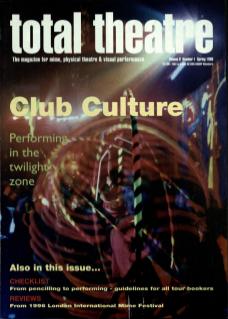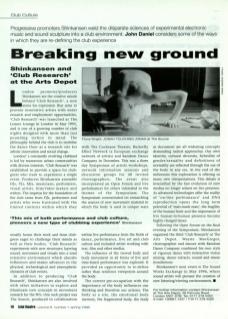London promoter/producers Shinkansen are the creative minds behind 'Club Research', a new arena for expression that aims to provide innovative artists with wider research and employment opportunities. Club Research was launched at The Leisure Lounge in London in May 1995, and is one of a growing number of club nights designed with more than just pounding techno in mind. The philosophy behind the club is to mobilise the dance floor as a research site for artistic innovation and social change.
London's constantly evolving clubland is led by numerous urban communities with diverse interests. Club Research was established to provide a space for club-goers who want to experience a single event. Producers Shinkansen assemble DJs, VJs, MJs, musicians, performers, visual artists, film/video makers and writers. The impetus for the foundation of the club came from DJs, performers and artists who were frustrated with the limited contexts within which they usually house their work, and from club-goers eager to challenge their minds as well as their bodies. Club Research experiments with new structures; layering sound, movement and visuals into a total, intensive environment which absorbs influences and makes advances in the physical, technological and atmospheric elements of club events.
In addition to producing Club Research, Shinkansen are also involved with other initiatives to explore and illuminate new concepts in movement research for the 90s. One such project was The Source, produced in collaboration with The Cochrane Theatre, Butterfly Effect Network (a European exchange network of artists), and Random Dance Company in December. This was a three-day Symposium of artists workshops, network information sessions, and discussion groups for 40 invited choreographers. The event also incorporated an Open Forum and live performances for others interested in the themes of the Symposium. The Symposium concentrated on researching the sources of new movement material in which the body is used in unique ways within live performance from the fields of dance, performance, live art and club culture and included artists working with text, film and other media.
The influence of the viewed body and body movement in all forms of live and time-based performance was explored. It provided an opportunity to redefine rather than reinforce viewpoints around the body.
The current preoccupation with the importance of the body influences our thinking and therefore our actions. The body as a site, the emotional body, memory, the fragmented body, the body as document are all widening concepts demanding radical approaches. Our own identity, cultural diversity, hybridity of gender/sexuality and definitions of normality are reflected through the use of the body in any era. At the end of the millennium this exploration is offering us many new interpretations. This debate is intensified by the fast evolution of new media no longer reliant on live presence. As advanced technologies offer the reality of 'online performance' and DNA reproduction opens the long term potential of 'man-made man', the fragility of the human body and the importance of live human-to-human presence become highly charged issues.
Following the Open Forum on the final evening of the Symposium, Shinkansen organised the third Club Research at The Arts Depot. Wayne MacGregor, choreographer and dancer with Random Dance Company combined his own style of vigorous dance with interactive vision mixing, dance extracts, sound and music installations.
Shinkansen's next event is The Sound Works Exchange in May 1996, where sound artists will pioneer the creation of new listening/viewing environments.

